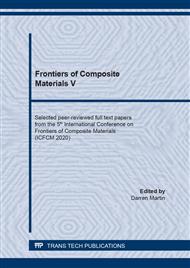p.17
p.23
p.29
p.37
p.47
p.57
p.69
p.75
p.81
Numerical Analysis of Microstructure Anomalies during Laser Welding Nickel-Based Single-Crystal Superalloy Part III: Amelioration of Solidification Behavior
Abstract:
The contribution of crystallography-dependent metallurgical factors, such as supersaturation of liquid aluminum and minimum dendrite tip undercooling, to solidification behavior and microstructure development is numerically analyzed during Ni-Cr-Al ternary single-crystal superalloy molten pool solidification to better understand thermodynamic and kinetic driving forces behind solidification cracking resistance. The variation of supersaturation of liquid aluminum and minimum dendrite tip undercooling with location of solid/liquid interface is symmetrically consistent in (001)/[100] welding configuration. By comparison, the variation is asymmetrically consistent in (001)/[110] welding configuration. The different distribution is attributed to growth crystallography and dendrite selection. Significant increase of supersaturation of liquid aluminum and dendrite tip undercooling from [010] dendrite growth region to [100] dendrite growth region preferentially aggravates microstructure development as result of nucleation and growth of stray grain formation with the same heat input on each half of the weld pool in (001)/[110] welding configuration. High heat input (both increasing laser power and decreasing welding speed) exacerbates supersaturation of liquid aluminum and dendrite tip undercooling by faster diffusion to incur stray grain formation with severity of contributing thermometallurgical factors for susceptibility to solidification cracking, while low heat input (both decreasing laser power and increasing welding speed) ameliorates microstructure development and increases resistance to solidification cracking. Weld microstructure of optimum welding conditions, such as combination of low heat input and (001)/[100] welding configuration, is less susceptible to solidification cracking to suppress asymmetrical microstructure development and improve weld integrity potential rather than insidious welding conditions, such as combination of high heat input and (001)/[110] welding configuration. Severer supersaturation of liquid aluminum and wider dendrite tip undercooling occur in the [100] dendrite region as consequence of alloying enrichment, while smaller supersaturation of liquid aluminum and narrower dendrite tip undercooling occur in the [001] dendrite region as consequence of alloying depletion to spontaneously facilitate epitaxial growth of single-crystal essential. Symmetrical (001)/[100] welding configuration decreases growth kinetics of dendrite tip with smaller overall supersaturation of liquid aluminum and dendrite tip undercooling than that of asymmetrical (001)/[110] welding configuration regardless of combination of laser power and welding speed. Mitigation of supersaturation of liquid aluminum and dendrite tip undercooling simultaneously alleviate crack-susceptible microstructure development and solidification cracking. Additionally, the appropriate mechanism of solidification cracking resistance improvement through modification of crystallography-dependent supersaturation and undercooling of dendrite tip is proposed. Calculation analyses are sufficiently explained by experiment results in a reasonable way. The additional purpose of this theoretical analysis is to evaluate solidification cracking susceptibility of similar nickel-based or iron-based single-crystal superalloys.
Info:
Periodical:
Pages:
47-56
Citation:
Online since:
August 2021
Authors:
Price:
Сopyright:
© 2021 Trans Tech Publications Ltd. All Rights Reserved
Share:
Citation:


